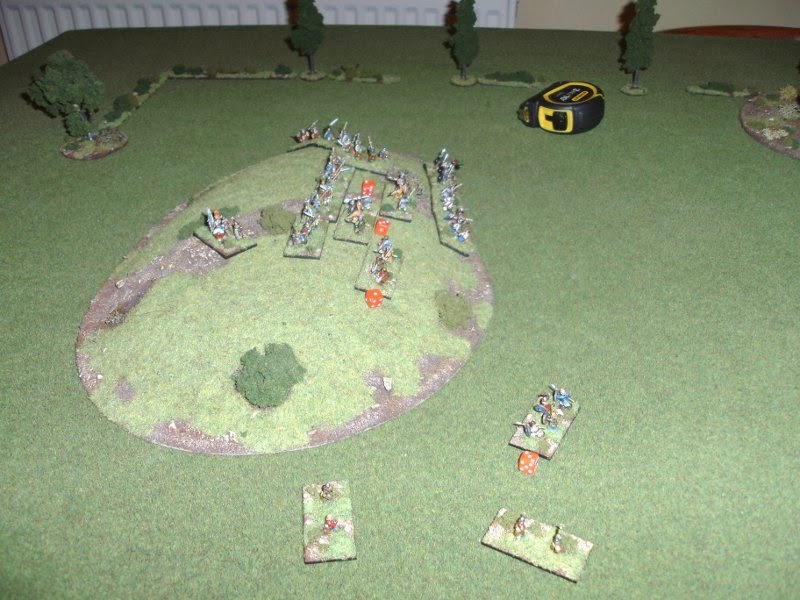Xmas is usually a quiet time on the gaming front for obvious reasons, but this year with the family away in Los Angeles (a long story) I was able to meet up with my friend Keith for a game or two of Dux Bellorum (he fancied something a bit different for once). I got everything set for when he arrived and so after the usual chat about wargaming etc, we sat down to play the 'River Battle' scenario straight from the book.
This turned into a bit of a slugging match over the ford as I had only made it wide enough for one unit to cross at a time, so wasn't a very challenging game to be honest. We both agreed that the ford needed to be wider in future and also that having the odd cavalry unit would help due to their greater mobility. Time was still on our side so we proceeded to play a straight 'Annals Battle' which was much more fun and challenging. Again we both agreed that the odd cavalry unit here and there would add another level to the game, so my partially painted cavalry for my Saxons have been bumped up the painting ladder as it were.
The following day I went to WH Smiths and bought the latest issue of Miniature Wargames magazine, which I thoroughly enjoy reading. By chance it had a scenario from Dux Bellorum author Dan Mersey in it based upon the historical 'Battle for Heavenfield', between Cadwallon and Oswald. I had left the table out from the previous night with the intention of playing a solo game or two from the book, but decided there and then to game the Heavenfield scenario as I had enough units for both forces from my collection of Pendraken figures.
Dan had also come up with a nice little pre-game idea where both players can bid secretly for certain terrain, re-inforcements etc. As I was playing solo I ignored this but am keen to try it out in future games. To my mind it looks a lot of fun and will add something extra to the game which is always a bonus in my book.
I won't go into the detail of the background of the battle here, but recommend that you buy the magazine instead. However I will give the forces for both sides to help understand the units on the table.
Oswald's Army - Repeller
1 x Saxon Shieldwall Companions (with Oswald)
3 x Saxon Noble Shieldwall
2 x Ordinary Irish Warriors
2 x Saxon Foot Skirmishers (I opted to equip them with bows)
2 Extra Leadership Points
Cadwallon's Army - Agressor
1 x Welsh Shieldwall Companions (with Cadwallon)
7 x Ordinary Welsh Shieldwall
2 x Saxon Ordinary Warriors
 |
| Oswald's forces deployed on the hill as per the historical battle, in a strong defensive position, facing the numerically larger force of Cadwallon. |
 |
| The shieldwall units deployed in the centre with the Irish Warriors and skirmishers on the right flank. |
How the game played out.
 |
| Cadwallon's line advanced en masse whilst the Irish Warriors and Saxon skirmishers of Oswald's army advanced to threaten Cadwallon's left flank. |
 |
| Cadwallon's army advance in unison this turn whilst the Warriors and Skirmishers continue to battle it out, with the Irish gaining the upper hand. |
 |
| Only Oswald's centre manages to advance with the Warriors continuing to fight it out. |
 |
| Cadwallon's Army attempts to envelope Oswald's Nobles, but is attacked in the rear by Irish Warriors. |
 |
| The battle descends into a confused melee, but Cadwallon's forces are under severe pressure, but crucially do not lose any units this turn. |
 |
| The inevitable happens and Cadwallon loses enough units to force a break test, which results in other units fleeing the battle, thereby taking him over 75% and thus 'losing' the game. |
As this was essentially an 'End of Reign' battle, it was a draw as neither side had succeeded in killing their opposite number. However Cadwallon's forces had lost 6 units to Oswald's 2, even before rolling for break tests. So in my mind a victory to Oswald and the death of Cadwallon, cut down near the stream as happened at the end of the real battle.
Post Game Thoughts
I found this a thoroughly entertaining game, made all the better by the background detail provided by Dan in his article. So here are a few thoughts on the game:
- Shieldwall units on a hill are damned hard to shift.
- The lack of skirmishers for Cadwallon told in the end as they helped Oswald's Irish Warriors win the flank battle. Also they are very useful at attacking shieldwall units with their hit on 5+.
- With the loss of the left flank, Cadwallon's army was always going to be in a tricky situation.
- If Cadwallon's force had made a unified attack on Oswald's Noble shieldwall from the front and side, this would have helped. In the end I was too hasty and commited the troops to soon and in a piecemeal fashion. Lesson hopefully learnt!
- Cavalry would have helped Cadwallon's army as their mobility might have been enough to un-lock Oswald's shieldwall. Dan does mention the option of this in his article.
So having had a few games in quick succession, I'm going to order a few more units from Pendraken to flesh out my existing armies. Broadly speaking these will be a mix of cavalry and foot, to allow me to field a Late Roman army as well as Irish and Pict allies. With Pendraken due to release some new Ancients ranges next year, these should be ideal for the latter.









































